采矿工程英语课文及练习 1-9 单元翻译
采矿英语翻译 (5)
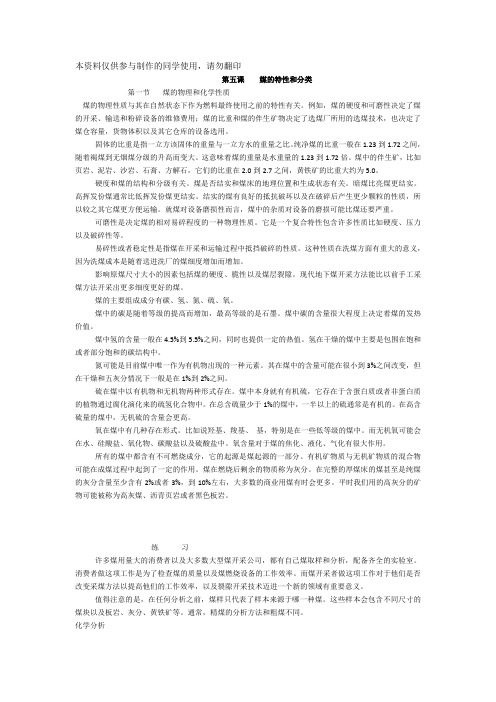
本资料仅供参与制作的同学使用,请勿翻印第五课媒的特性和分类第一节煤的物理和化学性质煤的物理性质与其在自然状态下作为燃料最终使用之前的特性有关。
例如,煤的硬度和可磨性决定了煤的开采、输送和粉碎设备的维修费用;煤的比重和煤的伴生矿物决定了选煤厂所用的选煤技术,也决定了煤仓容量,货物体积以及其它仓库的设备选用。
固体的比重是指一立方该固体的重量与一立方水的重量之比。
纯净煤的比重一般在1.23到1.72之间,随着褐煤到无烟煤分级的升高而变大。
这意味着煤的重量是水重量的1.23到1.72倍。
煤中的伴生矿,比如页岩、泥岩、沙岩、石膏、方解石,它们的比重在2.0到2.7之间,黄铁矿的比重大约为5.0。
硬度和煤的结构和分级有关。
煤是否结实和煤床的地理位置和生成状态有关。
暗煤比亮煤更结实。
高挥发份煤通常比低挥发份煤更结实。
结实的煤有良好的抵抗破坏以及在破碎后产生更少颗粒的性质,所以较之其它煤更方便运输。
就煤对设备磨损性而言,煤中的杂质对设备的磨损可能比煤还要严重。
可磨性是决定煤的相对易碎程度的一种物理性质。
它是一个复合特性包含许多性质比如硬度、压力以及破碎性等。
易碎性或者稳定性是指煤在开采和运输过程中抵挡破碎的性质。
这种性质在洗煤方面有重大的意义,因为洗煤成本是随着送进洗厂的煤细度增加而增加。
影响原煤尺寸大小的因素包括煤的硬度、脆性以及煤层裂隙。
现代地下煤开采方法能比以前手工采煤方法开采出更多细度更好的煤。
煤的主要组成成分有碳、氢、氮、硫、氧。
煤中的碳是随着等级的提高而增加,最高等级的是石墨。
煤中碳的含量很大程度上决定着煤的发热价值。
煤中氢的含量一般在4.5%到5.5%之间,同时也提供一定的热值。
氢在干燥的煤中主要是包围在饱和或者部分饱和的碳结构中。
氮可能是目前煤中唯一作为有机物出现的一种元素。
其在煤中的含量可能在很小到3%之间改变,但在干燥和五灰分情况下一般是在1%到2%之间。
硫在煤中以有机物和无机物两种形式存在。
采矿专业英语二
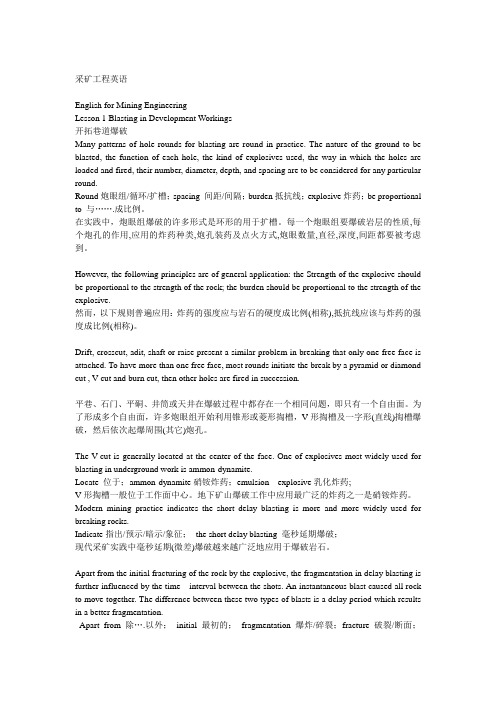
采矿工程英语English for Mining EngineeringLesson 1 Blasting in Development Workings开拓巷道爆破Many patterns of hole rounds for blasting are round in practice. The nature of the ground to be blasted, the function of each hole, the kind of explosives used, the way in which the holes are loaded and fired, their number, diameter, depth, and spacing are to be considered for any particular round.Round炮眼组/循环/扩槽;spacing 间距/间隔;burden抵抗线;explosive炸药;be proportional to 与…….成比例。
在实践中,炮眼组爆破的许多形式是环形的用于扩槽。
每一个炮眼组要爆破岩层的性质,每个炮孔的作用,应用的炸药种类,炮孔装药及点火方式,炮眼数量,直径,深度,间距都要被考虑到。
However, the following principles are of general application: the Strength of the explosive should be proportional to the strength of the rock; the burden should be proportional to the strength of the explosive.然而,以下规则普遍应用:炸药的强度应与岩石的硬度成比例(相称),抵抗线应该与炸药的强度成比例(相称)。
Drift, crosscut, adit, shaft or raise present a similar problem in breaking that only one free face is attached. To have more than one free face, most rounds initiate the break by a pyramid or diamond cut , V-cut and burn cut, then other holes are fired in succession.平巷、石门、平硐、井筒或天井在爆破过程中都存在一个相同问题,即只有一个自由面。
采矿工程专业英语(个人总结)
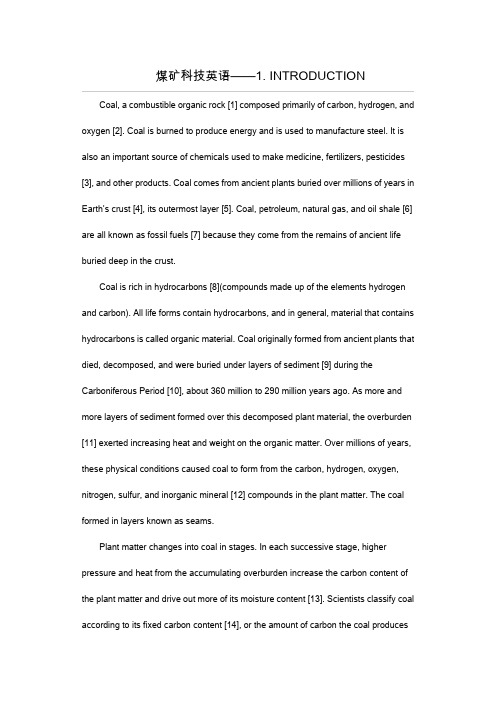
煤矿科技英语——1. INTRODUCTION Coal, a combustible organic rock [1] composed primarily of carbon, hydrogen, and oxygen [2]. Coal is burned to produce energy and is used to manufacture steel. It is also an important source of chemicals used to make medicine, fertilizers, pesticides [3], and other products. Coal comes from ancient plants buried over millions of years in Earth’s crust [4], its outermost layer [5]. Coal, petroleum, natural gas, and oil shale [6] are all known as fossil fuels [7] because they come from the remains of ancient life buried deep in the crust.Coal is rich in hydrocarbons [8](compounds made up of the elements hydrogen and carbon). All life forms contain hydrocarbons, and in general, material that contains hydrocarbons is called organic material. Coal originally formed from ancient plants that died, decomposed, and were buried under layers of sediment [9] during the Carboniferous Period [10], about 360 million to 290 million years ago. As more and more layers of sediment formed over this decomposed plant material, the overburden [11] exerted increasing heat and weight on the organic matter. Over millions of years, these physical conditions caused coal to form from the carbon, hydrogen, oxygen, nitrogen, sulfur, and inorganic mineral [12] compounds in the plant matter. The coal formed in layers known as seams.Plant matter changes into coal in stages. In each successive stage, higher pressure and heat from the accumulating overburden increase the carbon content of the plant matter and drive out more of its moisture content [13]. Scientists classify coal according to its fixed carbon content [14], or the amount of carbon the coal produceswhen heated under controlled conditions. Higher grades of coal have a higher fixed carbon content.NOTES TO THE TEXT[1] organic rock:有机岩[2] carbon, hydrogen, and oxygen:碳,氢和氧[3] pesticides:农药[4] Earth’s crust:地壳[5] outermost layer:最外层地层[6] oil shale:油页岩[7] fossil fuels:化石燃料[8] hydrocarbons:碳氢化合物[9] layers of sediment :沉积层[10] Carboniferous Period:石炭纪[11] overburden:覆盖岩层[12] inorganic mineral:无机材料[13] moisture content:含水量[14] fixed carbon content:固定碳含量煤矿科技英语——2. MODERN USES OF COAL Eighty-six percent of the coal used in the United States is burned by electric power plants [1] to produce electricity. When burned, coal generates energy in theform of heat. In a power plant that uses coal as fuel, this heat converts water into steam, which is pressurized to spin the shaft of a turbine. This spinning shaft [2] drives a generator that converts the mechanical energy of the rotation into electric power.Coal is also used in the steel industry. The steel industry uses coal by first heating it and converting it into coke [3], a hard substance consisting of nearly pure carbon. The coke is combined with iron ore [4] and limestone [5]. Then the mixture is heated to produce iron. Other industries use different coal gases given off during thecoke-forming process [6] to make fertilizers, solvents [7], medicine, pesticides, and other products.Fuel companies convert coal into easily transportable gas [8] or liquid fuels [9]. Coal-based vapor fuels [10] are produced through the process of gasification [11]. Gasification may be accomplished either at the site of the coalmine [12] or in processing plants [13]. In processing plants, the coal is heated in the presence of steam and oxygen to produce synthesis gas [14], a mixture of carbon monoxide [15], hydrogen, and methane [16] used directly as fuel or refined into cleaner-burning gas [17].On-site gasification [18] is accomplished by controlled, incomplete burning of an underground coal bed while adding air and steam. To do this, workers ignite the coal bed, pump air and steam underground into the burning coal, and then pump the resulting gases from the ground. Once the gases are withdrawn, they may be burned to produce heat or generate electricity. Or they may be used in synthetic gases to produce chemicals or to help create liquid fuels .Liquefaction [19] processes convert coal into a liquid fuel that has a composition similar to that of crude petroleum [20] Liquefaction. Coal can be liquefied either by direct or indirect processes. However, because coal is a hydrogen-deficient hydrocarbon [21], any process used to convert coal to liquid or other alternative fuels[22] must add hydrogen. Four general methods are used for liquefaction: (1) pyrolysis[23] and hydrocarbonization [24], in which coal is heated in the absence of air or in a stream of hydrogen; (2) solvent extraction [25], in which coal hydrocarbons are selectively dissolved and hydrogen is added to produce the desired liquids; (3) catalytic liquefaction [26], in which hydrogenation [27] takes place in the presence of a catalyst; and (4) indirect liquefaction, in which carbon monoxide and hydrogen are combined in the presence of a catalyst.NOTES TO THE TEXT[1] electric power plants:发电厂[2] spinning shaft:旋转轴[3] coke:焦炭[4] iron ore:铁矿石[5] limestone:石灰岩[6] coke-forming process:焦炭形成过程[7] solvents:溶剂[8] easily transportable gas:易输送的气体l[9] liquid fuels:液体燃料[10] coal-based vapor fuels:以媒为基础的气态燃料[11] gasification:气化[12] coalmine:煤矿[13] processing plants:加工厂[14] synthesis gas:合成煤气[15] carbon monoxide:一氧化碳[16] methane:沼气,甲烷[17] cleaner-burning gas:洁净煤气[18] on-site gasification:地下气化[19] liquefaction:液化[20] crude petroleum:原油[21] hydrogen-deficient hydrocarbon:缺氢碳氢化合物[22] alternative fuels:替代燃料[23] pyrolysis:高温分解[24] hydrocarbonization:碳氢化作用[25] solvent extraction:溶剂提取[26] catalytic liquefaction:催化液化作用[27] hydrogenation:氢化作用煤矿科技英语——3. FORMATION AND COMPONENTS OF COAL2006年8月1日12:40:0Coal is a sedimentary rock [1] formed from plants that flourished millions of years ago when tropical swamps [2] covered large areas of the world. Lush vegetation [3], such as early club mosses [4], horsetails [5], and enormous ferns, thrived in these swamps. Generations of this vegetation died and settled to the swamp bottom, and over time the organic material lost oxygen and hydrogen, leaving the material with a high percentage of carbon. Layers of mud and sand [6] accumulated over the decomposed plant matter, compressing and hardening the organic material as the sediments deepened. Over millions of years, deepening sediment layers, known as overburden, exerted tremendous heat and pressure on the underlying plant matter, which eventually became coal.Before decayed plant material [7] forms coal, the plant material forms a dark brown, compact organic material known as peat [8]. Although peat will burn when dried, it has a low carbon and high moisture content relative to coal. Most of coal’s heating value comes from carbon, whereas inorganic materials, such as moisture and minerals [9], detract from its heating value. For this reason, peat is a less efficient fuel source than coal. Over time, as layers of sediment accumulate over the peat, this organic material forms lignite [10], the lowest grade of coal. As the thickening geologic overburden gradually drives moisture from the coal and increases its fixed carbon content, coal evolves from lignite into successively higher-graded coals: subbituminous coal [11], bituminous coal [12], and anthracite [13]. Anthracite, the highest rank of coal, has nearly twice the heating value of lignite.Coal formation began during the Carboniferous Period (known as the first coalage), which spanned 360 million to 290 million years ago. Coal formation continued throughout the Permian [14], Triassic [15], Jurassic [16], Cretaceous [17], and Tertiary [18] Periods, which spanned 290 million to 1.6 million years ago. Coals formed during the first coal age are older, so they are generally located deeper in Earth’s crust. The greater heat and pressures at these depths produce higher-grade coals such as anthracite and bituminous coals. Conversely, coals formed during the second coal age under less intense heat and pressure are generally located at shallower depths. Consequently, these coals tend to be lower-grade subbituminous and lignite coals.Coal contains organic (carbon-containing) compounds transformed from ancient plant material. The original plant material was composed of cellulose [19], the reinforcing material [20] in plant cell walls [21]; lignin [22], the substance that cements plant cells together; tannins [23], a class of compounds in leaves and stems; and other organic compounds, such as fats and waxes. In addition to carbon, these organic compounds contain hydrogen, oxygen, nitrogen, and sulfur. After a plant dies and begins to decay on a swamp bottom, hydrogen and oxygen (and smaller amounts of other elements) gradually dissociate from the plant matter, increasing its relative carbon content.Coal also contains inorganic components, known as ash. Ash includes minerals such as pyrite [24] and marcasite [25] formed from metals that accumulated in the living tissues of the ancient plants. Quartz [26], clay, and other minerals are also added to coal deposits by wind and groundwater [27]. Ash [28] lowers the fixed carbon content of coal, decreasing its heating value.NOTES TO THE TEXT[1] sedimentary rock:沉积岩[2] tropical swamps:热带沼泽[3] Lush vegetation:茂盛的植物[4] club mosses:石松[5] horsetails:马尾(木贼属的一种植物)[6] layers of mud and sand:泥砂层[7] decayed plant material:腐烂的植物材料[8] peat:泥炭[9] minerals:矿物[10] lignite:褐煤[11] subbituminous coal:次烟煤[12] bituminous coal:烟煤[13] anthracite:无烟煤[14] Permian:二叠纪[15] Triassic:三叠纪[16] Jurassic:侏罗纪[17] Cretaceous:白垩纪[18] Tertiary:第三纪[19] cellulose:纤维素[20] reinforcing material:加固的材料[21] cell walls:细胞壁[22] lignin:木质[23] tannins:丹宁,鞣酸[24] pyrite:黄铁矿[25] marcasite :白铁矿[26] quartz:石英[27] groundwater:地下水[28] ash:灰分煤矿科技英语——4. COAL DEPOSITS ANDRESERVESAlthough coal deposits exist in nearly every region of the world, commercially significant coal resources occur only in Europe, Asia, Australia, and North America. Commercially significant coal deposits occur in sedimentary rock basins [3], typicallysandwiched as layers called beds or seams [4] between layers of sandstone [5] and shale [6]. When experts develop estimates of the world’s coal supply, they distinguish between coal reserves and resources. Reserves are coal deposits that can be mined profitably with existing technology—that is, with current equipment and methods. Resources are an estimate of the worl d’s total coal deposits, regardless of whether the deposits are commercially accessible. Exploration [7] geologists [8] have found and mapped the world’s most extensive coal beds. At the beginning of 2001, global coal reserves were estimated at 984.2 billion metric tons, in which 1 metric ton [9] equals 1,016 kg (2,240 lb). These reserves occurred in the following regions by order of importance: the Asia Pacific, including Australia, 29.7 percent; North America, 26.1 percent; Russia and the countries of the former Union of Soviet Socialist Republics (USSR), 23.4 percent; Europe, excluding the former USSR, 12.4 percent; Africa and the Middle East, 6.2 percent; and South and Central America, 2.2 percent.Coal deposits in the United Kingdom, which led the world in coal production until the 20th century, extend throughout parts of England, Wales, and southern Scotland. Coalfields in western Europe underlie the Saar and Ruhr valleys in Germany, the Alsace region of France, and areas of Belgium. Coalfields [10] in central Europe extend throughout parts of Poland, the Czech Republic, and Hungary. The most extensive and valuable coalfield in eastern Europe is the Donets Basin, between the Dnieper and Donrivers (in parts of Russia and Ukraine). Large coal deposits in Russia are being mined in the Kuznetsk Basin in southern Siberia. Coalfields underlying northwestern China are among the largest in the world. Mining of these fields began inthe 20th century.United States coal reserves are located in six major regions, three of which produce the majority of domestically [11] mined coal. The most productive region [12] in the United States is the Appalachian Basin, covering parts of Pennsylvania, West Virginia, Kentucky, Tennessee, Ohio, and Alabama. Large quantities of coal have also been produced by both the Illinois Basin—extending through Illinois, Indiana, and Kentucky—and the Western Interior Region—extending through Missouri, Kansas, and Oklahoma. Other commercially important U.S. coal regions include the Powder River Basin, underlying parts of Montana and Wyoming; the Green River Basin in Wyoming; the Uinta Basin, covering areas of Utah and Colorado; and the San Juan Basin, underlying parts of Utah, New Mexico and Colorado.In 2001 estimates of total U.S. coal reserves were approximately 246 billion metric tons. At the beginning of the 21st century production amounted to about 980 million metric tons each year.NOTES TO THE TEXT[1] coal deposit:煤矿床[2] reserves:储量[3] sedimentary rock basins:沉积岩盆地[4] seams:媒层[5] sandstone:砂岩[6] shale:页岩[7] exploration:勘探[8] geologist:地质学家[9] metric ton:公吨[10] coalfields:媒田[11] domestically:国内(产)地,民用地,家用地[12] productive region:生产区煤矿科技英语——5. BRIEF INTRODUCTION TO COALMININGCoal mining [1] is the removal of coal from the ground. The mining method employed to extract the coal depends on the following criteria: a. seam thickness [2], b. the overburden thickness, c. the ease of removal of the overburden, d. the ease withwhich a shaft [3] can be sunk to reach the coal seam, e. the amount of coal extracted relative to the amount that cannot be removed, and f. the market demand for the coal.The two types of mining methods are surface mining [4] and underground mining [5]. In surface mining, the layers of rock or soil overlying a coal seam are first removed after which the coal is extracted from the exposed seam. In underground mining, a shaft is dug to reach the coal seam. Currently, underground mining accounts for approximately 60 percent of the world recovery of coal.5-1 Surface MiningSurface mining is used to reach coal reserves that are too shallow to be reached by other mining methods. Types of surface mining include open-pit mining [6], drift mining [7], slope mining [8], contour mining [9], and auger mining [10].A. Open-pit MiningIn open-pit mining, or strip mining, earth-moving equipment is used to remove the rocky overburden and then huge mechanical shovels [11] scoop [12] coal up from the underlying deposit. The modern coal industry has developed some of the largest industrial equipment ever made, including shovels capable of holding 290 metric tons of coal.To reach the coal, bulldozers [13] clear the vegetation and soil. Depending on the hardness and depth of the exposed sedimentary rocks, these rocky layers may be shattered with explosives. To do this, workers drill blast holes [14] into the overlying sedimentary rock, fill these holes with explosives [15], and then blast the overburden to fracture the rock. Once the broken rock is removed, coal is shoveled from theunderlying deposit into giant earth-moving trucks [16] for transport [17].B. Drift MiningDrift mining is used when a horizontal seam [18] of coal emerges at the surface on the side of a hill or mountain, and the opening [19] into the mine can be made directly into the coal seam. This type of mining is generally the easiest and most economical type because excavation through rock is not necessary. If coal is available in this manner, it is likely to be mined.C. Slope MiningSlope mining occurs when an inclined opening is used to tap the coal seam (or seams). A slope mine may follow the coal seam if the seam is inclined and exposed to the surface, or the slope may be driven through rock strata overlying the coal to reach a seam. Coal transportation from a slope mine can be accomplished by conveyor [20] or by track haulage [21] (using a trolley locomotive [22] if the grade is not severe) or by pulling mine cars [23] up the slope using an electric hoist [24] and steel rope [25] if the grade is steep. The most common practice is to use a belt conveyor.D. Contour MiningContour mining occurs on hilly or mountainous terrain, where workers use excavation equipment to cut into the hillside along its contour to remove the overlying rock and then mine the coal. The depth to which workers must cut into the hillside depends on factors such as hill slope and coal bed thickness.E. Auger MiningAuger mining is frequently employed in open-pit mines where the thickness ofthe overburden is too great for open-pit mining to be cost-effective [26]. Open-pit mining would require the lengthy and costly removal of the overburden, whereas auger mining is more efficient because it cuts through the overburden and removes the coal as it drills. In this technique, the miners drill a series of horizontal holes into the coal bed with a large auger (drill) powered by a diesel or gasoline engine [27]. These augers are typically about 60 m (200 ft) long and 0.6 to 2.1 m (2 to 7 ft) in diameter. As these enormous drills bore into the coal seam, they discharge coal like a wood drill producing wood shavings. Additional auger lengths are added as the cutting head of the auger penetrates farther into the coal. Penetration continues until the cutting head drifts into the top or bottom of the coal seam, into a previous hole, or until the maximum torque [28] (energy required to twist an object) of the auger is reached.F. Satellite Aids [29] to Surface MiningIn the late 1990s some coal mining enterprises used technologies such as the global positioning system (GPS) [30] to help guide the positioning of mining equipment. Satellites operated by the United States Air Force Space Command and leased to companies for commercial use track the position of mining equipment against a map of a mine’s topography [31]. This map uses colors to distinguish soil that should be excavated, soil that should remain in place, and areas that should be filled in. The equipment driver observes this visual information [32] on a monitor [33] while operating the equipment. Some coal mining enterprises have used GPS to increase mining efficiency up to 30 percent.5-2 Underground MiningUnderground, or deep, mining occurs when coal is extracted from a seam without removal of the overlying strata. Miners build a shaft mine that enters the earth through a vertical opening and descends from the surface to the coal seam. In the mine, the coal is extracted from the seam by various methods, including conventional mining[34], continuous mining [35], longwall mining [36], and room-and-pillar mining [37].A. Conventional MiningConventional mining, also called cyclic mining, involves a sequence of operations that proceed in the following order: a. supporting the roof [38], b. ventilation [39], c. cutting [40], d. drilling [41], e. blasting [42], f. coal removal [43], and g. loading [44]. First, miners make the roof above the seam safe and stable by timbering [45] or by roof bolting [46], processes intended to prevent the roof from collapsing [47]. At the same time, they create ventilation openings so that dangerous gases [48] can escape and fresh air can reach the miners. Then one or more slots [49]—a few centimeters wide and extending for several meters into the coal—are cut along the face of the coal seam, also known as the wall face, by a large, mobile cutting machine [50]. The cut, or slot, provides easy access to the face and facilitates the breaking up of the coal, which is usually blasted from the seam by explosives known as permissible explosives. This type of explosive produces an almost flame-free explosion [51] and markedly reduces the amount of noxious fumes [52] in comparison with conventional explosives. The coal may then be transported by rubber-tired electric vehicles (shuttle cars) [53] or by chain (or belt) conveyor systems [54].B. Continuous MiningContinuous mining involves the use of a single machine known as a continuous miner that breaks the coal mechanically and loads it for transport. This mobile machine [55] has a series of metal-studded rotating drums [56] that gouge coal from the face of the coal seam. One continuous miner can mechanically break apart about 1.8 metric tons of coal per hour. Roof support is then installed, ventilation is advanced, and the coalface [57] is ready for the next cycle. The method used to transport the coal requires the installation of mobile belt conveyors.C. Longwall MiningThe longwall mining system uses a remote-controlled [58] self-advancing support [59] in which large blocks of coal are completely extracted in a continuous operation. Hydraulic or self-advancing jacks [60], known as chocks [61], support the roof at the immediate face as the coal is removed. As the face advances [62], the roof is allowed to collapse behind the remote-controlled, roof-building machinery [63]. Miners then remove the fallen coal. Coal recovery [64] is comparable to that attainable with the conventional or continuous mining systems.D. Room-and-Pillar MiningRoom-and-pillar mining is a means of developing a coalface and, at the same time, retaining supports for the roof. With this technique, rooms are developed from large, parallel tunnels driven into the solid coal [65], and the intervening pillars [66] of coal are used to support the roof. The percentage of coal recovered from a seam depends on the number and size of protective pillars of coal thought necessary to support the roof safely. Workers may remove some coal pillars just before closing themine.NOTES TO THE TEXT[1] coal mining:采煤[2] seam thickness:煤层厚度[3] shaft:立井[4] surface mining:地面开采[5] underground mining:地下开采[6] open-pit mining:露天矿开采[7] drift mining:平峒开采[8] slope mining:斜井开采[9] contour mining:台阶开采[10] auger mining:螺旋钻开采[11] mechanical shovels:机械铲[12] scoop:铲斗[13] bulldozer:推土机[14] blast holes:炮眼[15] explosives:炸药[16] earth-moving trucks:地面移动卡车[17] transport:运输,输送[18] horizontal seam:水平煤层[19] opening:坑道[20] conveyor:输送机[21] track haulage:轨道运输[22] trolley locomotive:架线式电机车[23] mine cars:矿车[24] electric hoist:电动提升机[25] steel rope:钢丝绳[26] cost-effective:成本效果[27] gasoline engine:汽油发动机[28] maximum torque:最大扭矩[29] satellite aids:卫星辅助[30] global positioning system (GPS):地球定位系统[31] topography:地形[32] visual information:可视信息[33] monitor:监控器,监视器[34] conventional mining:传统式开采法[35] continuous mining:连续(采煤机)式开采法[36] longwall mining:长壁式开采法[37] room-and-pillar mining:房柱式开采法[38] supporting the roof:支护顶板[39] ventilation:通风[40] cutting:截割,掏槽[41] drilling:钻眼[42] blasting:爆破,放炮[43] coal removal:出媒[44] loading:装载[45] timbering:木支架[46] roof bolting:顶板锚杆支护[47] collapsing:垮落,崩落[48] dangerous gases:危险气体[49] slot:槽,沟[50] mobile cutting machine:移动式截媒机[51] flame-free explosion:无焰爆破[52] noxious fumes:有毒烟雾[53] rubber-tired electric vehicles (shuttle cars):电动胶轮车(梭车)[54] chain (or belt) conveyor system:刮板(胶带)输送机系统[55] mobile machine:移动式机器[56] metal-studded rotating drums:金属双头螺栓式旋转滚筒[57] coalface:采煤工作面[58] remote-controlled:遥控的[59] self-advancing support:自移式支架[60] hydraulic or self-advancing jacks:液压或自移式千斤顶[61] chocks:垛式(液压)支架[62] face advances:工作面推进[63] roof-building machinery:筑顶机械[64] coal recovery:媒炭回收率[65] solid coal:实体煤[66] intervening pillars:煤房间的煤柱煤矿科技英语——6. LONGWALL MINING SYSTEMS Longwall mining has a long history of successful applications, even in thin and inclined coal seams [2]. This type of mining is more mechanized than any other method, and necessitates careful attention to the selection of the expensive equipment required. Longwall mining is a unique method with one principal variation. According to the direction of coal extraction, there are longwall advance mining [3] and longwall retreat mining [4].6-1 Longwall Advance MiningLongwall advance mining has been primarily used in the deeper underground mines where strata pressures [5] do not permit maintaining roadway [6] for long period of time.The majority of coalfields in Europe use longwall advance system of mining. The coal seam is divided into panels [7], generally 100 to 230m wide by up to 1800m long. Production may commence following a minimal capital outlay [8] for pre-production development. Yet the geological conditions [9] ahead of the advancing coalface may be uncertain, thus introducing an element of risk. Any sudden worsening of geological conditions may cause the production face to halt and an equipment capital outlay can be temporarily at a stand still. Shallow mining depths are not favored longwall advance mining; however, weak strata may require its use even though it may not suit NorthAmerican requirements for high productivity.A. Advance system with single entry [10]: The single entry is driven only a short distance ahead of the advancing face to avoid excessive frontal abutment pressures [11], The advance of roadways has been greatly improved through the use of longwall shearer [12] for roadway excavation.The main problem of the longwall advance system with single entry is maintaining the roadway behind face in the gob [13] for the life of the panel. Roadway support is provided by arches set [14]. The packs [15] are built along the gob edge for maintaining the roadway. The application of the Pump Pack [16] for pack building has reduced the difficulties relating to roadway maintenance [17].B. Advance system with double entries [18]: These have rib pillars [19] with a least width equal to or greater than one tenth of the panel depth separating panels. The ribs provide roadway protection against strata pressure deformation [20] effect. The driving of double entries in advance is integrated with the transport of coal from the longwall face. The main advantage of this system is that there is no need for roadway maintenance because one collapse is with the gob and the other in the rib is not affected by gob closure [21].The mining system requires more development work, but this is more than offset [22] by the savings in roadway maintenance.6-2. Longwall Retreat MiningLongwall retreat mining is basically the same as longwall advancing extraction, except that the coal seam is block-out [23] and then retreated in panels betweendevelopment roadways. Its advantages over advance mining are low risk and consistently high output. However, there are factors, which limit the application of retreat mining. The most important of which is the development of high stress [24] levels due to the influence of nearby workings, which affect the stability [25] of development roadways in soft strata. The life of the coalface depends upon the life of the roadway gate support. Reinforcement [26] techniques are available to assist in stabilizing the mine roadways.A. A retreat system with a single entry: this system is similar to the advance system with one entry, except that the panel is fully developed before extraction starts. There is a problem of roadway maintenance near the gob.This method has the advantages of economical use roadways and the efficient recovery of coal reserves. The mining direction is either down-dip [27] or along strike [28]. The disadvantages of the system are that the developed roadways in solid coal are liable to interaction from neighboring workings in the same seam: and the panel in extraction must be mined-out before the next one can start to avoid short circuiting ventilation.B. Integrated advance and retreat system [29]: this system is used mostly in deeper and gaseous coalmines. Single entry is used resulting in limited development and easier face-end [30] operations. Alternate faces advance in opposite directions. This method, as in other single entry longwall mining methods, re-uses the roadway of the mined-out panel for extraction of the adjacent panel. In some countries, integrated single entry system has been used to control surface subsidence strains.。
采矿工程英语翻译
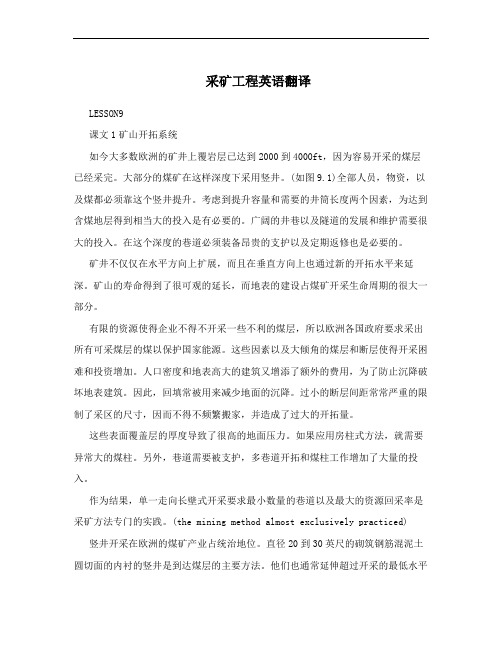
采矿工程英语翻译LESSON9课文1矿山开拓系统如今大多数欧洲的矿井上覆岩层已达到2000到4000ft,因为容易开采的煤层已经采完。
大部分的煤矿在这样深度下采用竖井。
(如图9.1)全部人员,物资,以及煤都必须靠这个竖井提升。
考虑到提升容量和需要的井筒长度两个因素,为达到含煤地层得到相当大的投入是有必要的。
广阔的井巷以及隧道的发展和维护需要很大的投入。
在这个深度的巷道必须装备昂贵的支护以及定期返修也是必要的。
矿井不仅仅在水平方向上扩展,而且在垂直方向上也通过新的开拓水平来延深。
矿山的寿命得到了很可观的延长,而地表的建设占煤矿开采生命周期的很大一部分。
有限的资源使得企业不得不开采一些不利的煤层,所以欧洲各国政府要求采出所有可采煤层的煤以保护国家能源。
这些因素以及大倾角的煤层和断层使得开采困难和投资增加。
人口密度和地表高大的建筑又增添了额外的费用,为了防止沉降破坏地表建筑。
因此,回填常被用来减少地面的沉降。
过小的断层间距常常严重的限制了采区的尺寸,因而不得不频繁搬家,并造成了过大的开拓量。
这些表面覆盖层的厚度导致了很高的地面压力。
如果应用房柱式方法,就需要异常大的煤柱。
另外,巷道需要被支护,多巷道开拓和煤柱工作增加了大量的投入。
作为结果,单一走向长壁式开采要求最小数量的巷道以及最大的资源回采率是采矿方法专门的实践。
(the mining method almost exclusively practiced) 竖井开采在欧洲的煤矿产业占统治地位。
直径20到30英尺的砌筑钢筋混泥土圆切面的内衬的竖井是到达煤层的主要方法。
他们也通常延伸超过开采的最低水平为以后的扩展提供保障。
如在美国,立井是用打眼,放炮和挖掘方法或用大直径钻井设备来开凿的。
立井打眼频繁的使用,尤其在小的短的阶段井筒,可以连接不同的水平但不能延伸到表面。
井筒中的运输是通过提升在多级罐笼里的装满煤的矿车或者是吊车来完成的。
煤浆的抽出在特殊的情况下也这样做。
采矿工程英语译文

练习1矿井系统选择的标准图9.2显示了各种采矿方法的生产分布图。
由于现在在短壁工作面工作的少于12个人,所以采用长臂综采法。
很显然连续采煤法越来越受欢迎不是因为每个单元的生产能力增加,而是因为相同吨位的产出需要的人少。
然而,长臂开采的生产率更高是因为每个采矿单元与生俱来的连续开采潜力使其有更大的生产能力。
虽然如此,讨论选择一个系统比另一个系统好要考虑很多因素,这样会让每种形式的细节分析变得明显。
这个表格列出了很多矿井选择特定系统时考虑的各种因素,提供了像自然条件,开采经验,社会关注点,市场条件等重要因素。
一些选择是相当明显的,然而一些是不明显的。
通常,这些选择更能反映出个人偏见。
例如,当缝隙是坚硬的或包含坚硬的杂质,传统的开采方法(爆破)比通过连续开采剥开煤层更容易。
当眼前的隧道顶部很坏时,长臂开采更容易也能够提供更全面的支撑。
常规开采需求的大量设备可能会导致柔软底部的撕裂,所以常规开采比连续开采需要一个坚固的底部。
由于常规开采在房柱式系统已经比在任何老矿区实行时间都长,由于劳动监察部门最熟悉这种方法和设备,在新矿的开采方法选取中这将是一个重要的考虑因素。
然而,如果对于新的从业人员,选择这种传统方法是不太可能的,因为它需要更多的技巧去协调许多设备以及人力。
但是,对于维护人员就不是这样的。
由于传统设备比连续采矿设备更简单,更可靠,更容易保持状态,一个没有经验的维修组更适合使用常规开采的矿区。
市场对于采矿系统的发展有过很大的影响。
而连续开采通常认为已经开始约在1947年,实际上再更早就有了。
在1920年代早期,McKinley Entry Driver,一个出生很早地使用连续开采方法的矿工,加入的很多条目在Illinois.然而煤炭生产靠它,和几乎如今的所有连续开采矿工,这对于全国上下的取暖需求不是很畅销,所以它产生了低回报。
随着实用市场的到来,所有的煤都是粉碎后使用的,连续采煤机已获得广泛的认可。
采矿英语
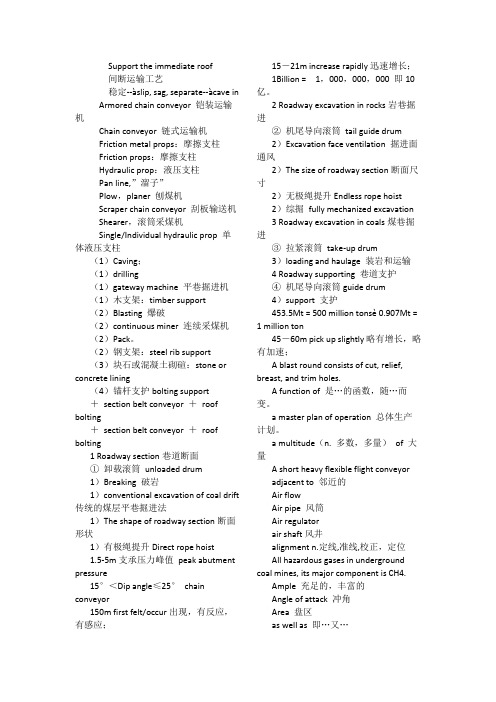
Support the immediate roof间断运输工艺稳定--àslip, sag, separate--àcave inArmored chain conveyor 铠装运输机Chain conveyor 链式运输机Friction metal props:摩擦支柱Friction props:摩擦支柱Hydraulic prop:液压支柱Pan line,”溜子”Plow,planer 刨煤机Scraper chain conveyor 刮板输送机Shearer,滚筒采煤机Single/Individual hydraulic prop 单体液压支柱(1)Caving;(1)drilling(1)gateway machine 平巷掘进机(1)木支架:timber support(2)Blasting 爆破(2)continuous miner 连续采煤机(2)Pack。
(2)钢支架:steel rib support(3)块石或混凝土砌碹:stone or concrete lining(4)锚杆支护bolting support+section belt conveyor +roof bolting+section belt conveyor +roof bolting1 Roadway section巷道断面①卸载滚筒unloaded drum1)Breaking 破岩1)conventional excavation of coal drift 传统的煤层平巷掘进法1)The shape of roadway section断面形状1)有极绳提升Direct rope hoist1.5-5m支承压力峰值peak abutment pressure15°<Dip angle≤25°chain conveyor150m first felt/occur出现,有反应,有感应;15-21m increase rapidly迅速增长;1Billion = 1,000,000,000 即10亿。
翻译
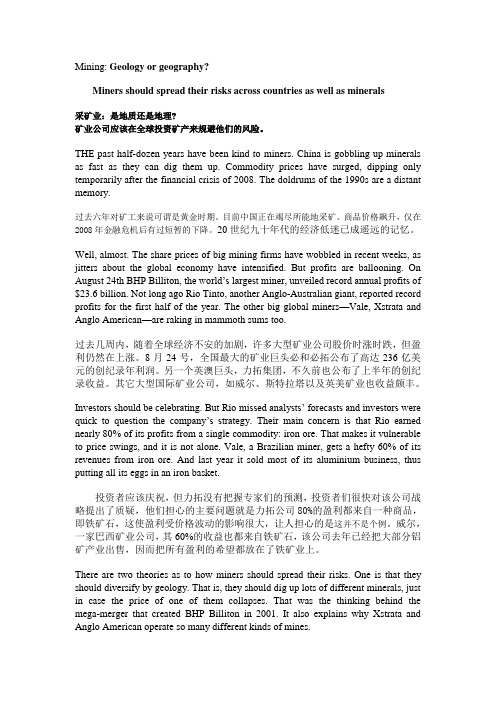
Mining: Geology or geography?Miners should spread their risks across countries as well as minerals采矿业:是地质还是地理?矿业公司应该在全球投资矿产来规避他们的风险。
THE past half-dozen years have been kind to miners. China is gobbling up minerals as fast as they can dig them up. Commodity prices have surged, dipping only temporarily after the financial crisis of 2008. The doldrums of the 1990s are a distant memory.过去六年对矿工来说可谓是黄金时期。
目前中国正在竭尽所能地采矿。
商品价格飙升,仅在2008年金融危机后有过短暂的下降。
20世纪九十年代的经济低迷已成遥远的记忆。
Well, almost. The share prices of big mining firms have wobbled in recent weeks, as jitters about the global economy have intensified. But profits are ballooning. On August 24th BHP Billiton, the world’s largest miner, unveiled record annual profits of $23.6 billion. Not long ago Rio Tinto, another Anglo-Australian giant, reported record profits for the first half of the year. The other big global miners—Vale, Xstrata and Anglo American—are raking in mammoth sums too.过去几周内,随着全球经济不安的加剧,许多大型矿业公司股价时涨时跌,但盈利仍然在上涨。
采矿工程英语考试点缩印版

名词翻译(20)井工开采underground mining 露天开采strip(open pit) mining 长壁开采longwall mining 房柱开采room-and-pillar mining 运输巷道travelling roadway 地表下沉surface subsidence 矿山压力underground pressure支撑压力abutment pressure矿压显现strata behavior 地板隆起floor heave 顶板控制ground control 通风管理ventilation control前进式回采advancing woking 煤炭自燃spontaneous combustion of coal 直接顶immediate roof 岩层力学strata mechanics正断层normal fault 逆断层reversed fault 采区working area/section 采空区mined-out gob液压支架powered support 后退式回采retreating woking 支护系统support system 运输系统haulage system垛式支架chock support 老顶main roof 掩护式支架shield-type support 额定工作阻力yield loads岩理结构rock structure 工作面运输巷headentry 工作面回风巷tailentry汉译英(20)+英译汉(30)1、The discovery that certain black rock would burn was undoubtedly accidental and probably occurred independently and many times in the world over thousands of years.发现这种黑色石头能够燃烧肯定是偶然的,这个现象可能是在几千年间世界上(不同地方的人们)独立发现的。
采矿工程专业英语翻译
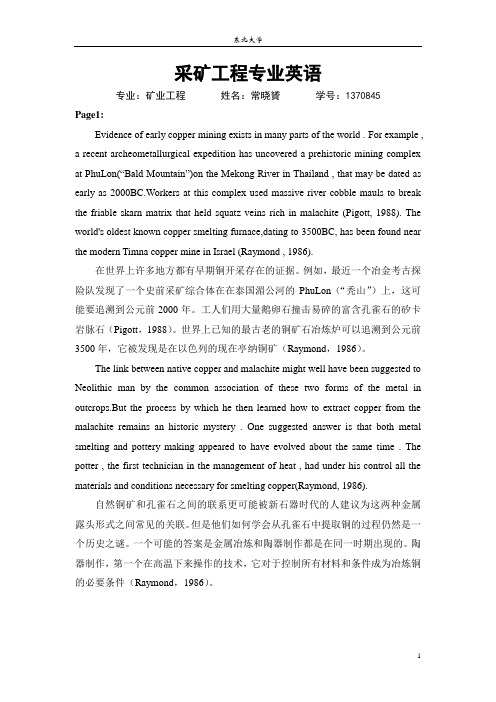
采矿工程专业英语专业:矿业工程姓名:常晓贇学号:1370845Page1:Evidence of early copper mining exists in many parts of the world . For example , a recent archeometallurgical expedition has uncovered a prehistoric mining complex at PhuLon(“Bald Mountain”)on the Mekong River in Thailand , that ma y be dated as early as 2000BC.Workers at this complex used massive river cobble mauls to break the friable skarn matrix that held squatz veins rich in malachite (Pigott, 1988). The world's oldest known copper smelting furnace,dating to 3500BC, has been found near the modern Timna copper mine in Israel (Raymond , 1986).在世界上许多地方都有早期铜开采存在的证据。
例如,最近一个冶金考古探险队发现了一个史前采矿综合体在在泰国湄公河的PhuLon(“秃山”)上,这可能要追溯到公元前2000年。
工人们用大量鹅卵石撞击易碎的富含孔雀石的矽卡岩脉石(Pigott,1988)。
世界上已知的最古老的铜矿石冶炼炉可以追溯到公元前3500年,它被发现是在以色列的现在亭纳铜矿(Raymond,1986)。
The link between native copper and malachite might well have been suggested to Neolithic man by the common association of these two forms of the metal in outcrops.But the process by which he then learned how to extract copper from the malachite remains an historic mystery . One suggested answer is that both metal smelting and pottery making appeared to have evolved about the same time . The potter , the first technician in the management of heat , had under his control all the materials and conditions necessary for smelting copper(Raymond, 1986).自然铜矿和孔雀石之间的联系更可能被新石器时代的人建议为这两种金属露头形式之间常见的关联。
采矿工程英语翻译
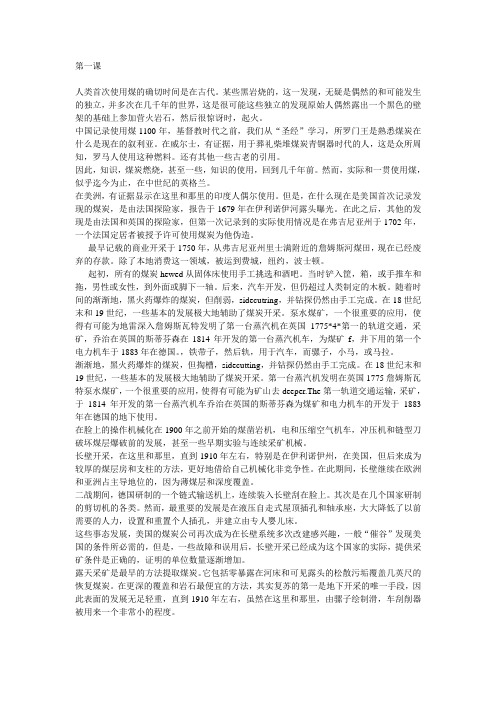
第一课人类首次使用煤的确切时间是在古代。
某些黑岩烧的,这一发现,无疑是偶然的和可能发生的独立,并多次在几千年的世界,这是很可能这些独立的发现原始人偶然露出一个黑色的壁架的基础上参加营火岩石,然后很惊讶时,起火。
中国记录使用煤1100年,基督教时代之前,我们从“圣经”学习,所罗门王是熟悉煤炭在什么是现在的叙利亚。
在威尔士,有证据,用于葬礼柴堆煤炭青铜器时代的人,这是众所周知,罗马人使用这种燃料。
还有其他一些古老的引用。
因此,知识,煤炭燃烧,甚至一些,知识的使用,回到几千年前。
然而,实际和一贯使用煤,似乎迄今为止,在中世纪的英格兰。
在美洲,有证据显示在这里和那里的印度人偶尔使用。
但是,在什么现在是美国首次记录发现的煤炭,是由法国探险家,报告于1679年在伊利诺伊河露头曝光。
在此之后,其他的发现是由法国和英国的探险家,但第一次记录到的实际使用情况是在弗吉尼亚州于1702年,一个法国定居者被授予许可使用煤炭为他伪造。
最早记载的商业开采于1750年,从弗吉尼亚州里士满附近的詹姆斯河煤田,现在已经废弃的存款。
除了本地消费这一领域,被运到费城,纽约,波士顿。
起初,所有的煤炭hewed从固体床使用手工挑选和酒吧。
当时铲入筐,箱,或手推车和拖,男性或女性,到外面或脚下一轴。
后来,汽车开发,但仍超过人类制定的木板。
随着时间的渐渐地,黑火药爆炸的煤炭,但削弱,sidecutring,并钻探仍然由手工完成。
在18世纪末和19世纪,一些基本的发展极大地辅助了煤炭开采。
泵水煤矿,一个很重要的应用,使得有可能为地雷深入詹姆斯瓦特发明了第一台蒸汽机在英国1775*4*第一的轨道交通,采矿,乔治在英国的斯蒂芬森在1814年开发的第一台蒸汽机车,为煤矿f,井下用的第一个电力机车于1883年在德国。
,铁带子,然后轨,用于汽车,而骡子,小马,或马拉。
渐渐地,黑火药爆炸的煤炭,但掏槽,sidecutting,并钻探仍然由手工完成。
在18世纪末和19世纪,一些基本的发展极大地辅助了煤炭开采。
采矿英语翻译
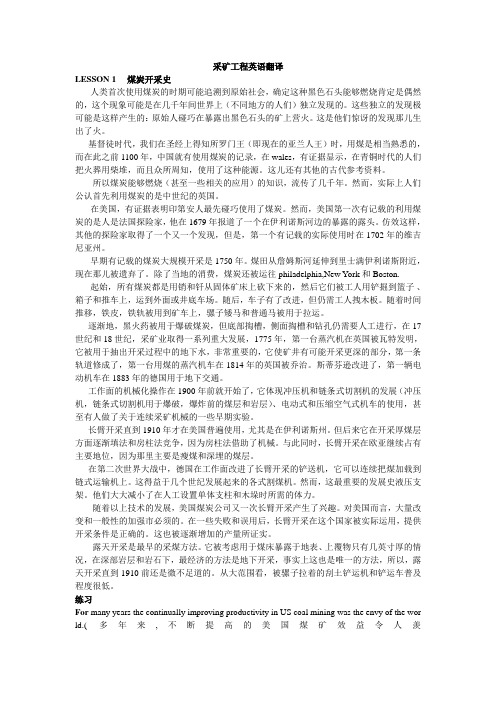
采矿工程英语翻译LESSON 1 煤炭开采史人类首次使用煤炭的时期可能追溯到原始社会,确定这种黑色石头能够燃烧肯定是偶然的,这个现象可能是在几千年间世界上(不同地方的人们)独立发现的。
这些独立的发现极可能是这样产生的:原始人碰巧在暴露出黑色石头的矿上营火。
这是他们惊讶的发现那儿生出了火。
基督徒时代,我们在圣经上得知所罗门王(即现在的亚兰人王)时,用煤是相当熟悉的,而在此之前1100年,中国就有使用煤炭的记录,在wales,有证据显示,在青铜时代的人们把火葬用柴堆,而且众所周知,使用了这种能源。
这儿还有其他的古代参考资料。
所以煤炭能够燃烧(甚至一些相关的应用)的知识,流传了几千年。
然而,实际上人们公认首先利用煤炭的是中世纪的英国。
在美国,有证据表明印第安人最先碰巧使用了煤炭。
然而,美国第一次有记载的利用煤炭的是人是法国探险家,他在1679年报道了一个在伊利诺斯河边的暴露的露头。
仿效这样,其他的探险家取得了一个又一个发现,但是,第一个有记载的实际使用时在1702年的维吉尼亚州。
早期有记载的煤炭大规模开采是1750年。
煤田从詹姆斯河延伸到里士满伊利诺斯附近,现在那儿被遗弃了。
除了当地的消费,煤炭还被运往philadelphia,New York和Boston.起始,所有煤炭都是用销和钎从固体矿床上砍下来的,然后它们被工人用铲掘到篮子、箱子和推车上,运到外面或井底车场。
随后,车子有了改进,但仍需工人拽木板。
随着时间推移,铁皮,铁轨被用到矿车上,骡子矮马和普通马被用于拉运。
逐渐地,黑火药被用于爆破煤炭,但底部掏槽,侧面掏槽和钻孔仍需要人工进行,在17世纪和18世纪,采矿业取得一系列重大发展,1775年,第一台蒸汽机在英国被瓦特发明,它被用于抽出开采过程中的地下水,非常重要的,它使矿井有可能开采更深的部分,第一条轨道修成了,第一台用煤的蒸汽机车在1814年的英国被乔治。
斯蒂芬逊改进了,第一辆电动机车在1883年的德国用于地下交通。
采矿专业英语文章带翻译

英译汉Underground Mining Methods地下采矿方法Room and Pillar Mining房柱采矿法Ramps (inclined tunnels) are excavated to connect the surface to the underground orebody. Drifts (horizontal tunnels) are excavated at different elevations to surround the orebody. Next, stopes (tunnels that have direct access to mining the ore) are mined to gain access to the ore. All tunnels are excavated by drilling and blasting. Jumbos are in charge of drilling the holes in the rocks and filling them with explosives. The loose rock, also called muck, is transported by either dump trucks back up to the surface for either waste disposal or processing.矿体由隧道(斜井)与地表联通。
阶段运输巷道分布在矿体的不同水平。
接下来,在采场采场开采矿石。
所有巷道通过钻孔和爆破的方式开掘的。
钻车是用来在岩石上钻研和并将钻孔填装炸药。
松动的岩石,也称为废石,由自卸卡车运输至废石场。
As mucking progresses, rooms (tunnels) are cut into the ore body. In order to provide safe roof support for mining, pillars of material around the rooms are left standing to hold up the rock ceiling above. Some parts of the mine roof can be particularly weak and fragile. In addition to pillar support, a jumbo is then brought back in for rock bolting of the roof to ensure safety.随着巷道的掘进,矿体被分割成矿块。
采矿工程英语
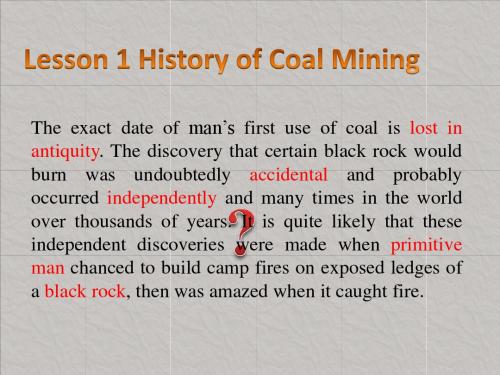
The Chinese recorded the use of coal 1,100 years before the Christian Era. In Wales, there is evidence that the Bronze Age people used coal for funeral pyres, and it is known that the Romans used this fuel. There are other ancient references. However, practical and consistent use of coal seems to date to England in the Middle Ages. However, the first recorded discovery of coal, in what is now US, was by French explorers, who reported an outcrop exposure on the Illinois River in 1679. The first recorded actual usage was in Virginia in 1702 to use coal for a French settler’s forge.
hewed by hand from
shoveled into baskets, boxes, or wheelbarrows and dragged by men, or women to the foot of a shaft(竖井) Later, cars were developed but still drawn over wood plank by humans
采矿英语翻译 (6)
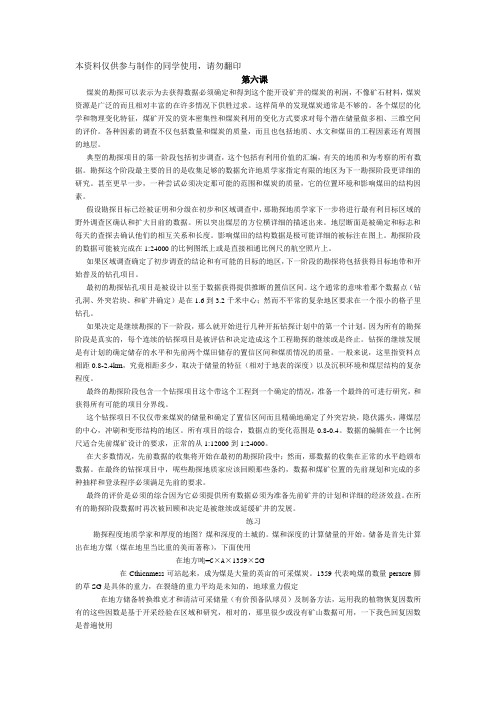
本资料仅供参与制作的同学使用,请勿翻印第六课煤炭的勘探可以表示为去获得数据必须确定和得到这个能开设矿井的煤炭的利润,不像矿石材料,煤炭资源是广泛的而且相对丰富的在许多情况下供胜过求。
这样简单的发现煤炭通常是不够的。
各个煤层的化学和物理变化特征,煤矿开发的资本密集性和煤炭利用的变化方式要求对每个潜在储量做多相、三维空间的评价。
各种因素的调查不仅包括数量和煤炭的质量,而且也包括地质、水文和煤田的工程因素还有周围的地层。
典型的勘探项目的第一阶段包括初步调查,这个包括有利用价值的汇编,有关的地质和为考察的所有数据。
勘探这个阶段最主要的目的是收集足够的数据允许地质学家指定有限的地区为下一勘探阶段更详细的研究。
甚至更早一步,一种尝试必须决定那可能的范围和煤炭的质量,它的位置环境和影响煤田的结构因素。
假设勘探目标已经被证明和分级在初步和区域调查中,那勘探地质学家下一步将进行最有利目标区域的野外调查区确认和扩大目前的数据。
所以突出煤层的方位横详细的描述出来。
地层断面是被确定和标志和每天的查探去确认他们的相互关系和长度。
影响煤田的结构数据是极可能详细的被标注在图上。
勘探阶段的数据可能被完成在1:24000的比例图纸上或是直接相通比例尺的航空照片上。
如果区域调查确定了初步调查的结论和有可能的目标的地区,下一阶段的勘探将包括获得目标地带和开始普及的钻孔项目。
最初的勘探钻孔项目是被设计以至于数据获得提供推断的置信区间。
这个通常的意味着那个数据点(钻孔洞、外突岩块、和矿井确定)是在1.6到3.2千米中心;然而不平常的复杂地区要求在一个很小的格子里钻孔。
如果决定是继续勘探的下一阶段,那么就开始进行几种开拓钻探计划中的第一个计划。
因为所有的勘探阶段是真实的,每个连续的钻探项目是被评估和决定造成这个工程勘探的继续或是终止。
钻探的继续发展是有计划的确定储存的水平和先前两个煤田储存的置信区间和煤质情况的质量。
一般来说,这里指资料点相距0.8-2.4km,究竟相距多少,取决于储量的特征(相对于地表的深度)以及沉积环境和煤层结构的复杂程度。
采矿专业英语词汇
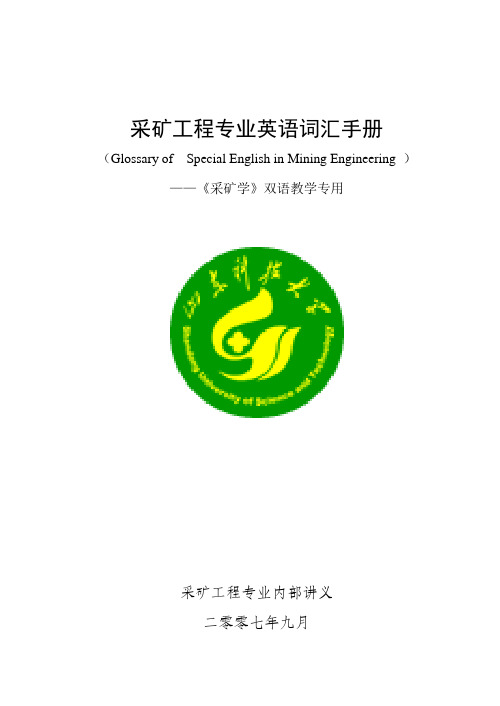
采矿工程专业英语词汇手册(Glossary of Special English in Mining Engineering )——《采矿学》双语教学专用采矿工程专业内部讲义二零零七年九月Content目录Introduction (2)绪论 (2)Chapter 1 Basic concepts of Coal Mining (2)第一章煤矿开采的基本概念 (2)Chapter 2 Coal Mining methods (5)第二章采煤方法的概念和种类 (5)Section I Mine Field Development and Mining Design第一篇井田开拓及矿井开采设计Chapter 3 Basic Concepts of Mine Development (8)第三章井田开拓的基本概念 (8)Chapter 4 Mine Development W ays (10)第四章井田开拓方式 (10)Chapter 5 Development Roadways Layout ..... (12)第五章井田开拓巷道布置 (12)Chapter 6 Level station ….………………………………………………………..…第六章井底车场…………………………………………………….…Chapter 7 Mine Development Deepen and T echnical Reform…………………………………第七章矿井开拓延深和技术改造………………………………………….…Introduction (绪论)mine n. 矿山,矿井。
v. 采矿colliery n. 矿井coal mining 采煤underground mining 地下开采surface mining 露天开采reserve n. 储量coal-bearing adj. 含煤的high production and high efficiency 高产高效development n. 开拓preparation n. 准备mining method 采煤方法subside v. 下沉,沉陷subsidence n. 沉降,沉陷mining subsidence n. 开采沉陷mechanize v. 使…机械化mechanization n. 机械化Chapter 1 Basic Concepts of Mine (矿井基本概念)coalfield n. 煤田mining area n. 矿区mine field n. 井田divide v. 划分division n. 划分mine production capacity (MPC)矿井生产能力mine service life 矿井服务年限production scale of mine 井型small mine 小型矿井middle mine 中型矿井large mine 大型矿井huge mine 特大型矿井strike n. 走向dip n. 倾向dip angle 倾角workable adj. 可采的workable reserve n. 可采储量opening n. 通道,开口mine opening n. 矿山井巷passageway n. 通道shaft n. 立井roadway n. 巷道chamber n. 硐室main shaft 主立井auxiliary shaft 副立井air shaft 风井blind shaft 暗立井drawn shaft 溜井chute n. 溜煤眼adit n. 平硐drift n. 平硐crosscut n. 联络巷;石门coal crosscut煤门entry n. 平巷haulage n. 运输main haulage roadway 主要运输平巷main return-air roadway 主要回风平巷head entry 区段运输平巷tail entry 区段回风平巷slope n. 斜井rise n. 上山dip n. 下山rock rise 岩石上山coal rise 煤层上山coal haulage rise 运煤上山material transporting rise 运料上山return-air rise 回风上山men-walking rise 行人上山inclined roadway of a strip 分带斜巷inclined coal haulage roadway of a strip 分带运煤斜巷inclined material haulage roadway of a strip 分带运料斜巷development roadway 开拓巷道preparation roadway 准备巷道gateway 回采巷道pit bottom 井底车场shaft bottom 井底车场station n. 车场,车站mining district station 采区车场horizon n. 阶段level n. 水平haulage level 运输水平return-air level 回风水平mining level 开采水平interval between levels 阶段垂高mining district 采区panel n. 盘区sublevel n. 分段strip district n. 带区inclined length 斜长strike length 走向长度district sublevel区段Open-off cut n. 切眼coalface n. 采煤面working face工作面production n. 生产;产量production system 生产系统coal haulage system 运煤系统ventilation n. 通风ventilation system通风系统fresh air 新鲜风dirty air 乏风,污风refuse n. 矸石material and refuse transportation system 运料排矸系统drain v. 排水drainage system 排水系统power supply system (electric power, compressed air) 动力供应(电、压风)communication and monitoring system 通讯、监测系统drive v. 掘进excavate v. 开挖,开掘hoist v. 提升winch n. 绞车Chapter 2 Coal Mining methods (采煤方法)stope 采场mining works/units 回采工作basic operation 基本工序break v. 破碎load v. 装载haul v. 运输auxiliary operations 辅助工序roof support 顶板支护gob treatment 采空区处理auxiliary transportation 辅助运输ventilation 通风drainage 排水power supply 供电,emulsion supply 供液(乳化液)等。
采矿工程专业英语(部分重要文章翻译)
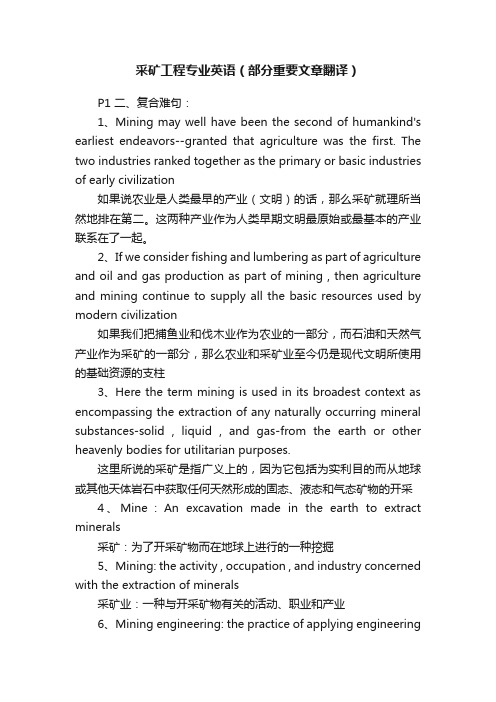
采矿工程专业英语(部分重要文章翻译)P1 二、复合难句:1、Mining may well have been the second of humankind's earliest endeavors--granted that agriculture was the first. The two industries ranked together as the primary or basic industries of early civilization如果说农业是人类最早的产业(文明)的话,那么采矿就理所当然地排在第二。
这两种产业作为人类早期文明最原始或最基本的产业联系在了一起。
2、If we consider fishing and lumbering as part of agriculture and oil and gas production as part of mining , then agriculture and mining continue to supply all the basic resources used by modern civilization如果我们把捕鱼业和伐木业作为农业的一部分,而石油和天然气产业作为采矿的一部分,那么农业和采矿业至今仍是现代文明所使用的基础资源的支柱3、Here the term mining is used in its broadest context as encompassing the extraction of any naturally occurring mineral substances-solid , liquid , and gas-from the earth or other heavenly bodies for utilitarian purposes.这里所说的采矿是指广义上的,因为它包括为实利目的而从地球或其他天体岩石中获取任何天然形成的固态、液态和气态矿物的开采4、Mine:An excavation made in the earth to extract minerals采矿:为了开采矿物而在地球上进行的一种挖掘5、Mining: the activity , occupation , and industry concerned with the extraction of minerals采矿业:一种与开采矿物有关的活动、职业和产业6、Mining engineering: the practice of applying engineeringprinciples to the development ,planning , operation , closure and reclamation of mines.采矿工程:运用工程原理生产、规划、运作和关闭(充填)以及对矿山再利用(复垦)的一种实践7、Mineral:A naturally occurring inorganic element or compound having an orderly internal structure and a characteristic chemical composition , crystal form , and physical properties.矿物:一种天然形成的无机元素或化合物(无机物),它有着有序的内部构造、特有的化学成分、结晶形式和物理性质。
采矿工程 专业英语 山科大重点(2013年 新编)

☐metallic ore 金属矿石☐nonmetallic mineral 非金属矿物☐coal 煤☐petroleum 石油☐natural gas 天然气☐ground control 岩层控制☐ventilation 通风☐haulage 运输☐hoisting 提升☐rock breakage 破岩☐surrounding rock mass 围岩,周围岩层☐dynamite [dainəmait] n. 炸药☐mine n. 矿山,矿井。
v. 采矿☐mining n.采矿,采矿业,采掘行业☐mineral n. 矿物☐mine development 矿井开拓☐mine planning 矿井设计☐mine operation 矿井作业☐mine closure 矿井关闭☐mine reclamation 矿区恢复治理☐ore n. 矿石☐gangue n. [ɡæŋ] 夹石,夹矸n. 脉石☐waste n. 废石☐mineral deposit 矿床☐prospecting 勘探,探矿☐exploration 勘探,探测☐development 开拓☐exploitation 开采☐reclamation [﹑reklə′meɪʃən]恢复治理,复垦☐colliery [′kɔliəri]n. 矿井,煤矿☐surface mining 露天开采☐shaft 井筒,立井☐slope 斜井☐adit 平硐☐open pit mining 基坑式露天开采井,煤矿☐open cast mining (strip mining) 倒堆式露天开采☐stripe 条带stripe mining 条带开采☐aqueous mining method [′eikwiəs]水采方法☐underground mining 地下开采☐unsupported mining 空场法/无支护法☐supported mining 有支护法☐caving mining 垮落法/崩落法☐unit operations 单元作业;工序☐production operation 生产工序,主要工序☐materials handling 物料搬运☐drill 钻眼☐blast 爆破☐load 装载unload,dump,卸载☐haul 运输☐auxiliary operation 辅助工序☐roof support 顶板支护☐ventilation and air-conditioning 通风和空气调节☐power supply 供电☐pumping;drainage 排水☐maintenance 设备维护☐communications 通讯☐lighting 照明☐delivery of compressed air, water 供水和压缩空气☐supplies to the working sections 其它材料供应☐provide slope stability 保持边坡稳定☐waste disposal 废物处理☐supply of material 材料供应☐Prospecting 找矿☐Exploration 勘探☐Development 开拓☐Exploitation 回采☐Reclamation 恢复治理☐☐fossil ['fɒs(ə)l; -sɪl] n. 化石。
- 1、下载文档前请自行甄别文档内容的完整性,平台不提供额外的编辑、内容补充、找答案等附加服务。
- 2、"仅部分预览"的文档,不可在线预览部分如存在完整性等问题,可反馈申请退款(可完整预览的文档不适用该条件!)。
- 3、如文档侵犯您的权益,请联系客服反馈,我们会尽快为您处理(人工客服工作时间:9:00-18:30)。
随着以上技术的发展,美国煤炭公司又一次长臂开采产生了兴趣。对美国而言,大量改变和一般性的加强市必须的。在一些失败和误用后,长臂开采在这个国家被实际运用,提供开采条件是正确的。这也被逐渐增加的产量所证实。
There are certainly solutions to all of these problems, which are challenges that a young person entering the industry should welcome as great opportunities.(当然要解决所有这些问题,对于一个年轻人进入这个受欢迎的行业有更多的机会但是富有挑战的。)
这些问题都有一定的解决办法,进入该行业的年轻人应该把这些挑战当作巨大的机会来欢迎。
LESSON 2
煤的成因
煤是大量植物材料
估计表明大约0.9到2.1m的适当紧密结合的植物材料能够形成0.3m的烟煤。那么,允许很厚的植物材料堆积多次,这种植物材料有时覆盖几百甚至几千平方英里的条件是什么呢?
油页岩 Total
总量
Quadrillions of Btu 17307 2373 1906 7 4064 25653
表1.1 productivity per man day.(人均日产量) Metric equivalent:(公式等效)
1 stX0.9071847=t
4) A shortage of qualified supervisory and engineering personnel,as well as mine workers,to meet the growing demand for coal and the increasingly more difficult mining conditions.(缺乏合格的监督和工程人员,以及煤炭工人,来满足日益增长的煤炭需求和越来越多的困难开采条件。)
现在的问题是面对新的安全和环保需求的同时去复苏过去稳定的增长。
所有化石燃料的储备都是有限的,但是美国煤炭的储量比石油,天然气,油页岩和油砂大。像许多公司相信的那样,即使煤炭储量超过估计,这种比其他化石燃料的优势是很明显的,表1.1。所有化石燃料的储备都是有限的,所以为了世界长久的发展要拥有核能。遥远的未来也许能看到所有的化石燃料比例如化工溶剂,润滑剂,汽油,化学制品等锅炉燃料更多的使用。
练习 译文 第二种
第一课的exercise(page3)
有很多年美国煤炭产业生产率的不断提高令世界羡慕。这种稳定的增长意味着尽管在出资,原料,税收和其他生产花费上增长很大但是对消费者的价格却保持相当的水平甚至相对下降。然而,据官方报道,从1968年以来这种趋势急剧下降因为联邦新的严格的安全规定;地表水的严格控制以及空气污染和大量新引进的不断进行的改革。看图表1.1
尽管煤炭非常重要,企业仍面临着许多问题,例如:
在开采和消费时产生的空气和水污染
新的繁重的联邦新安全规定
公众反对露天开采和在一些情况下缺乏令人满意的恢复
缺乏合理的监督和工程人员及煤炭工人去面对对煤炭更多的要求和煤炭开采更加困难的情况
需要改进机械,技术和管理能力以恢复前些年生产率和成本的提高
逐渐地,黑火药被用于爆破煤炭,但底部掏槽,侧面掏槽和钻孔仍需要人工进行,在17世纪和18世纪,采矿业取得一系列重大发展,1775年,第一台蒸汽机在英国被瓦特发明,它被用于抽出开采过程中的地下水,非常重要的,它使矿井有可能开采更深的部分,第一条轨道修成了,第一台用煤的蒸汽机车在1814年的英国被乔治。斯蒂芬逊改进了,第一辆电动机车在1883年的德国用于地下交通。
2) The onerous new Federal safety regulations.( 繁重的新的联邦安全条例。)
3) Public outcry against surface mining and lack of satisfactory restoration in some cases.(公众强烈抗议露天采矿和一定程度上缺乏满意的地表修复。)
Despite the tremendous importance of coal,the industry is faced with serious problems,such as;(尽管有重大意义的煤、产业正面临著严峻的问题,如)
1) Air and water pollution both at the mines and at the consuming end. (空气和水的污染在矿山和消费两者间结束。)
露天开采是最早的采煤方法。它被考虑用于煤床暴露于地表、上覆物只有几英寸厚的情况,在深部岩层和岩石下,最经济的方法是地下开采,事实上这也是唯一的方法,所以,露天开采直到1910前还是微不足道的。从大范围看,被骡子拉着的刮土铲运机和铲运车普及程度很低。
练习 译文 第一种
For many years the continually improving productivity in US coal mining was the envy of the world.( 多年来,不断提高的美国煤矿效益令人羡慕)。 Such steady improvement meant a fairly level, or even slightly declining,price to the consumer despite large increases in wages,materials,taxes,and other costs of production.(这样的稳步提高意味着相当的水平,或甚至轻微下降,给消费者尽管价格大幅上涨工资、材料、税收、和其他生产成本。) However,this trend has drastically declined since 1968 because of the new stringent Federal safety regulations;rigid controls on surface water,and air pollution;and the mass of newly introduced,and constantly changing,bureaucratic reports. (然而,这种趋势自1968年以来数量急剧下降,因为新的严格的联邦安全法规,严格控制地表水,空气污染,及新引进的各种标准,并且不断在改变着,官僚主义报告)。 The problem now is to not only meet the new safety and environmental requirements but,at the same time,to revive the steady progress of the past. (现在的问题是,不仅要满足新的安全、环保要求,而且,与此同时,还要来恢复过去稳步前进的步伐。) Reserves of all fossil fuels are limited,but the United States has more reserves in coal than in oil,gas,oil shale,and tar sands combined.( 所有化石燃料储量是有限的,但美国有更多的储备在煤比石油、天然气、石油页岩,沥青沙的总和。) Even if coal reserves are over estimated ,as some in the industry believe,the relative dominance compared to other fossil fuels is apparent.(即使煤炭储量在估计, 如果像一些业内人士相信, 相对优势比其它化石燃料是很明显的.) Reserves of all fossil fuels are finite,so far the long pull the world is forture in having nuclear energy.( 储备的化石燃料是有限的,到目前为止,世界的长远计划是寄托在核能。) The distant future may see all fossil fuels consumed for higher uses than boiler fuel,for example,petrochemicals,lubricants,gasoline,chemicals,etc. (在遥远的未来可能会看到所有化石燃料在其他方面的消耗比锅炉燃料的使用更高,例如、石化、润滑油、汽油、化学品等。)
所以煤炭能够燃烧(甚至一些相关的应用)的知识,流传了几千年。然而,实际上人们公认首先利用煤炭的是中世纪的英国。
在美国,有证据表明印第安人最先碰巧使用了煤炭。然而,美国第一次有记载的利用煤炭的是人是法国探险家,他在1679年报道了一个在伊利诺斯河边的暴露的露头。仿效这样,其他的探险家取得了一个又一个发现,但是,第一个有记载的实际使用时在1702年的维吉尼亚州。
Table 1.1 US Reserves of Fossil Fuels Expressed in Heat Value.( 表1.1美国储备的化石燃料热值表达)
Reserves
储量 Coal
煤 Oiቤተ መጻሕፍቲ ባይዱ
石油 Natural gas天然气 Tar sands
油砂 Oil shale
早期有记载的煤炭大规模开采是1750年。煤田从詹姆斯河延伸到里士满伊利诺斯附近,现在那儿被遗弃了。除了当地的消费,煤炭还被运往philadelphia,New York和Boston.
起始,所有煤炭都是用销和钎从固体矿床上砍下来的,然后它们被工人用铲掘到篮子 、箱子和推车上,运到外面或井底车场。随后,车子有了改进,但仍需工人拽木板。随着时间推移,铁皮,铁轨被用到矿车上,骡子矮马和普通马被用于拉运。
